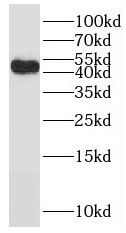Products
SMAD4 antibody
Category:
Research Area:
- SPECIFICATIONS
- Product Name
- SMAD4 antibody
- Catalogue No.
- FNab07996
- Size
- 100μg
- Form
- liquid
- Purification
- Immunogen affinity purified
- Purity
- ≥95% as determined by SDS-PAGE
- Clonality
- polyclonal
- Isotype
- IgG
- Storage
- PBS with 0.02% sodium azide and 50% glycerol pH 7.3, -20℃ for 12 months(Avoid repeated freeze / thaw cycles.)
Immunogen
- Immunogen
- SMAD family member 4
- Alternative Names
- DPC4 antibody, MADH4 antibody
- UniProt ID
- Q13485
- Observed MW
- 60 kDa
Application
- Tested Applications
- ELISA, WB, IHC, IF
- Recommended dilution
- WB: 1:500-1:2000; IHC: 1:20-1:200; IF: 1:20-1:200
Validated Images
 HEK-293 cells were subjected to SDS PAGE followed by western blot with FNab07996(SMAD4 antibody) at dilution of 1:600
HEK-293 cells were subjected to SDS PAGE followed by western blot with FNab07996(SMAD4 antibody) at dilution of 1:600
 Immunohistochemical of paraffin-embedded human breast cancer using FNab07996(SMAD4 antibody) at dilution of 1:100
Immunohistochemical of paraffin-embedded human breast cancer using FNab07996(SMAD4 antibody) at dilution of 1:100
- Background
- In muscle physiology, plays a central role in the balance between atrophy and hypertrophy. When recruited by MSTN, promotes atrophy response via phosphorylated SMAD2/4. MSTN decrease causes SMAD4 release and subsequent recruitment by the BMP pathway to promote hypertrophy via phosphorylated SMAD1/5/8. Acts synergistically with SMAD1 and YY1 in bone morphogenetic protein(BMP)-mediated cardiac-specific gene expression. Binds to SMAD binding elements(SBEs)(5'-GTCT/AGAC-3') within BMP response element(BMPRE) of cardiac activating regions(By similarity). Common SMAD(co-SMAD) is the coactivator and mediator of signal transduction by TGF-beta(transforming growth factor). Component of the heterotrimeric SMAD2/SMAD3-SMAD4 complex that forms in the nucleus and is required for the TGF-mediated signaling. Promotes binding of the SMAD2/SMAD4/FAST-1 complex to DNA and provides an activation function required for SMAD1 or SMAD2 to stimulate transcription. Component of the multimeric SMAD3/SMAD4/JUN/FOS complex which forms at the AP1 promoter site; required for synergistic transcriptional activity in response to TGF-beta. May act as a tumor suppressor. Positively regulates PDPK1 kinase activity by stimulating its dissociation from the 14-3-3 protein YWHAQ which acts as a negative regulator.



